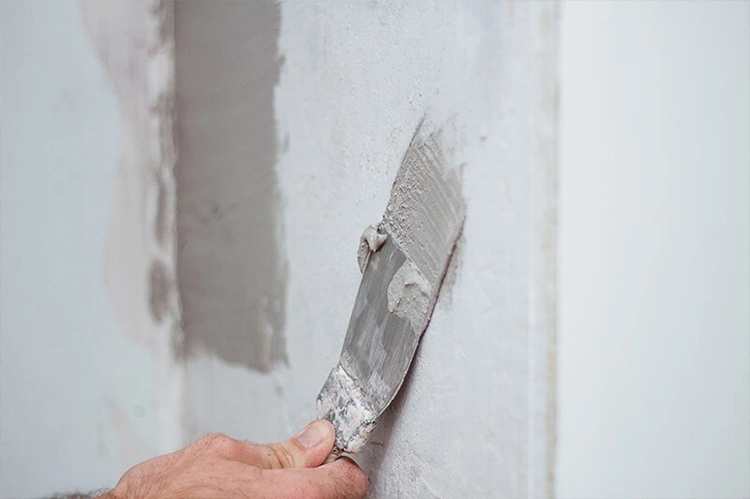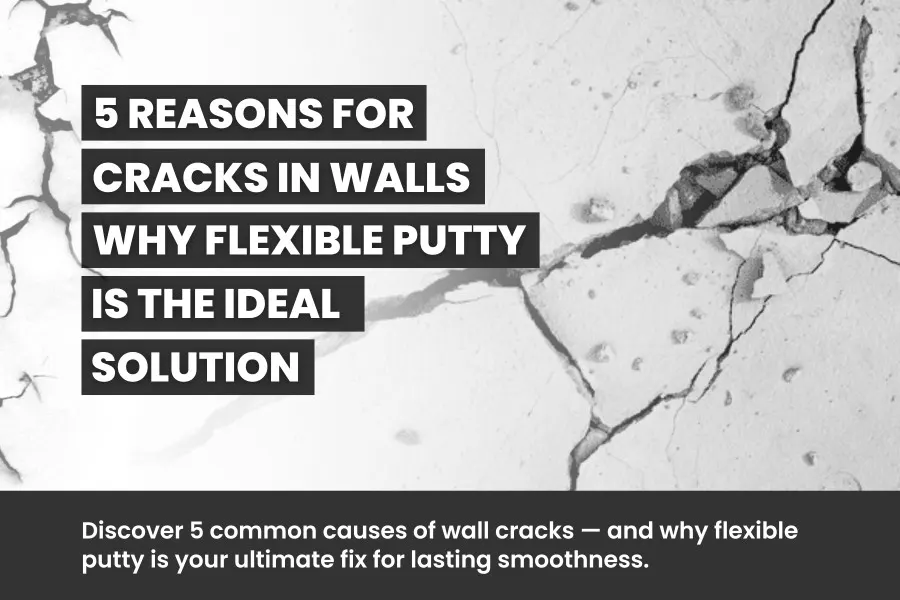Have you walked into a room recently and noticed little lines running up the wall? Maybe they were above a door frame or quietly along the corner of the ceiling.
Cracks in walls are something most homeowners will encounter at one time but while they may seem harmless at first glance, they can be a marker of much bigger issues.
Whether you’ve lived in a home that is decades old or you’re in a brand new apartment, understanding the reasoning behind cracks in walls is crucial to maintaining the beauty and structure of your property.
Table of Contents
In this blog we will going to take you through some of the most common causes of wall cracks, explain the difference between structural and non-structural cracks, and help you understand why flexible putty is one of the best ways to repair them.
I’m also going to add some personal experiences, because I’ve dealt with more than my fair share of wall woes (and a few DIY mess-ups) along the way.

So what do wall cracks actually mean?
Cracks can be unsettling, especially when you do not know what the cause is. Some are purely harmless surface imperfections, though some can indicate something considerably worse such as structural damage. This is why it is so important to understand the reasons for cracks.
Cracks typically fall into two broad categories:
1. Structural Cracks
These are the real heavy hitters—the cracks you do NOT want to ignore. Structural cracks develop from extreme stress put on the building.
Structural cracks result from foundation settlement, loading on the structural components, or forces from nature like an earthquake. Structural cracks are often wide and jagged, often traversing the wall erratically.
If a wall crack is wide enough to fit a coin into, or appears to be getting worse, then it is likely structural. You should definitely call a professional right away.
2. Non-Structural Cracks
These are more common, and usually a less serious problem. Non-structural wall cracks result from shrinkage of materials, temperature changes, moisture changes, or slight settling and are typically thin and of uniform width.
While non-structural cracks generally do not threaten the structural integrity of the building, they can substantially detract from the appearance of the wall; and possibly even allow moisture intrusion and pests into the wall after long periods unattended.
Let’s take a closer look at each of the five main reasons for cracks in walls— especially those of a non-structural nature that are very easily repaired with flexible putty.
The 5 Most Common Reasons for Cracks in Walls: Why Flexible Putty Is the Ideal Solution
1. Dry Shrinkage: The Silent Wall Splitter
One of the most common causes of minor cracks in walls is dry shrinkage. Dry shrinkage is caused by water evaporating from materials such as cement, mortar, and plaster during the drying cycle. When these materials dry, they shrink. That shrinkage can result in cracks appearing on a wall’s surface.
If you have constructed or remediated, you may see cracks appear within the first few months after completion as a result of dry shrinkage.
I remember painting my living room a mere few weeks after our contractor plastered it, simply to find those fine lines reappearing like magic. That was when I learned that because I didn’t seal the wall with flexible putty before painting, I’d created more work for myself.
2. Thermal Expansion and Contraction: The Weather Effect
Walls are affected by temperature changes more than most people realize. When the weather heats up, the materials commonly used in walls, concrete, plaster, expand.
When the weather cools, they contract. The ongoing expansion and contraction of walls put stress on them, and after a time, cracks developed.
Improved temperature variations are particularly striking in circumstances in which temperature variation can be extreme. My cousin, who lives in Rajasthan, faces this constantly.
The summer heat can be unbearable, and the winter cold is amazing. As a result, and despite being newly painted, there are sometimes cracks in the walls. Flexible putty has helped her with all of this again by absorbing the thermal stress rather than passing it directly to the surface paint.
3. Movement due to Moisture: Humidities Hidden Damage
Water may not be a source of immediate concern, but it can ruin walls. When moisture infiltrates wall materials, especially seeping into porous materials, they will expand.
Later, as the moisture dries, the material will contract. This continuous cycle of swelling and contracting can create cracks.
Areas of high humidity, such as kitchens, bathrooms, and coastal houses, are more likely to be damaged. Once those cracks form, they provide an even better opportunity for groundwater infiltration, which hastens further material loss.
In this type of environment, flexible putty with moisture resistance is an outstanding preventative measure that serves to preserve wall integrity and lessen future maintenance costs.
4. Inflexible or biodegradable wall putty
Regular putty does not possess the elasticity that is needed for wall movement. When the wall beneath moves (be it as a result of shrinkage, thermal expansion, or minor lateral shifting), the rigid putty film can not follow.
Flexible wall putty, conversely, is intended to be flexible. It stretches, contracts, and absorbs movement just like your skin does when you bend your joints. That flexibility makes it the ideal shield for your walls, especially in scenarios where movement is common.
5. Bad Practice
Sometimes, the cracks stem from how the wall was constructed. If individuals did not make the mortar tightly enough, or did not allow proper curing of the wall, or they worked when conditions were not conducive, the wall is a time bomb for cracking in the future.
We have seen situations where, due to a lack of surface preparation, the wall cracked as soon as a few weeks after construction completion.
Luckily, most minor imperfections can be compensated after painting or renovating with flexible putty applied as a preparatory layer. This will ensure a better and more durable wall surface.
Why Flexible Putty is the Solution?
Now that we have gone over the most important reasons for cracking walls, let’s focus on the solution. Most putties will cover a crack temporarily but do not fix the issue. Flexible putty does just that and more.
Here’s why flexible putty is a true game changer:
Elastic Properties
Flexible putty is made from polymers, which means when stretched and compressed, it won’t crack. This allows flexible putty to adapt to movement caused by temperature change, humidity, or slight shifts in the wall due to settling.
Crack Resistance
When properly applied, flexible putty acts as a cushion between the paint and the wall surface. If the wall moves or cracks underneath, the flexible putty can absorb that movement and will not allow it to transfer to the surface layer.
Durability
Flexible putty outlasts the typical putties since it is of a higher-grade formula, resisting wear, moisture, and stress. This means there are fewer touch-up paints and less repainting in the future.
Better Finish
Flexible putty lies flat and smooth, allowing for the best surface before applying paint. The paint will adhere better and look more refined and professional after painting.
How to Apply Flexible Putty? (In 6 Simple Steps)
Even if you are not a handyman, you can apply flexible putty if you are working with small wall cracks. Here is a simple outline of applying flexible putty:
Step 1: Clean the Area
Before stepping in the application of the flexible putty, make sure to remove any dust, dirt, and loose debris around your crack. A clean surface makes the adhesive properties of the putty to work better.
Step 2: Prepare the Crack
If you have a very narrow crack, take a putty knife and run it along the crack so it widens slightly. This will help the flexible putty attach.
Apply Flexible Putty
Using A Flexible Putty Knife, apply a generous quantity of putty into the crack, agreeable it in and smooth out the surface.
Drying Time
Allow the putty to dry completely. This may take a few hours, depending on humidity and temperature.
Sanding and Painting
Once dry, sand the surface smooth and paint.
Where Else Can You Use Flexible Putty?
Although it is most often used for walls, flexible putty can also work well on:
Ceilings (particularly around air vents and lights)
Wooden furniture and doors (to repair nail holes, dents ,and small cracks)
Window frames (in areas expecting slight movement)
If you need a little extra strength and weather-resistant properties, some companies make a flexible epoxy putty that works great in outdoor applications or in situations where water exposure is expected.

FAQs: Wall Cracks & Flexible Putty
Q1: Can flexible putty be applied to freshly plastered walls?
Yes, in fact, it is highly recommended to apply flexible putty onto freshly plastered walls because it creates a buffer against any shrink-related cracks that will occur during the curing process.
Q2: How often should flexible putty be reapplied?
If used properly, flexible putty will last for years. You only need to reapply it if new cracks start to form or if you decide to paint the surface again.
Q3: Can flexible putty be painted?
Yes! After it has dried and is sanded smooth, flexible putty can be painted just like a regular wall!
Q4: Can flexible putty fix structural cracks?
No. Structural cracks require a professional. Flexible putty is used for non-structural cracks that have been caused by natural elements or by the minor movement of the materials.
Q5: What is the difference between flexible and regular putty?
Regular putty is rigid and brittle. Flexible putty contains polymers to allow it to stretch and compress. Because of this, flexible putty is much better at preventing recurring cracks.
Sagar Telrandhe is a Construction Engineer with a B.Tech in Construction Engineering & Management. Passionate about infrastructure development, project planning, and sustainable construction, he specializes in modern construction techniques, project execution, and quality management, contributing to efficient and innovative building.


